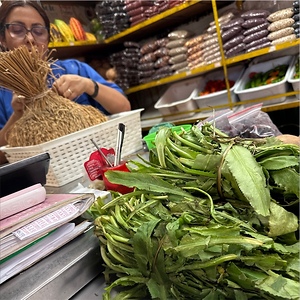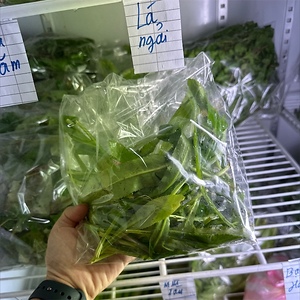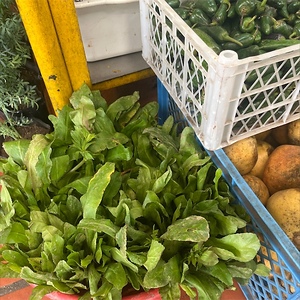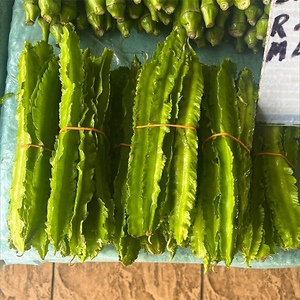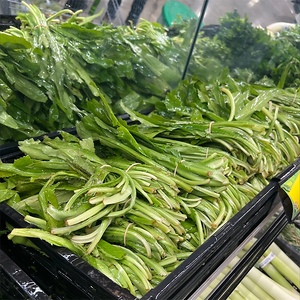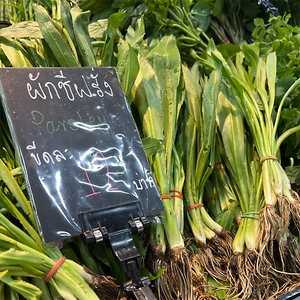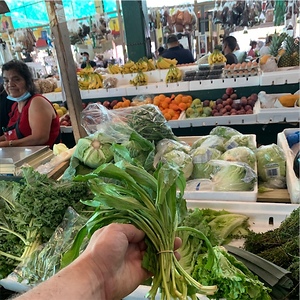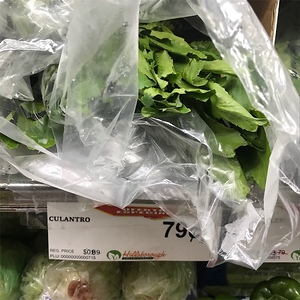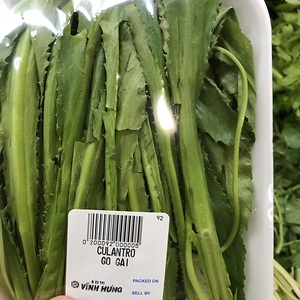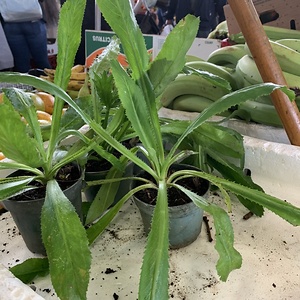


Culantro
Estimated Inventory, lb : 2.72
This item was last sold on : 07/29/25
Description/Taste
Culantro is a small herb with long and serrated, lanceolate-shaped leaves, averaging 25 to 30 centimeters in length and 4 to 5 centimeters in diameter, arranged in a rosette pattern around a central stem. The leaves are glossy, dark green, broad, and flat with small, toothed edges, and each tooth may contain a tiny yellow spine. The spines are generally harmless, but older leaves may irritate the skin when harvested with bare hands. Seasonally, a flower stem extends above the leaves and is covered in spikes and flowers. Culantro has a strong, musky aroma reminiscent of the citrus, earthy, and herbal notes of cilantro. The scent is also sometimes likened to the smell of stinkbugs, a skunk-like, sweet, and grassy aroma. Culantro has a robust, vegetal, and herbaceous flavor with bitter, citrusy, tangy, and peppery nuances.
Seasons/Availability
Culantro is available year-round.
Current Facts
Culantro, botanically classified as Eryngium foetidum, is an aromatic herb belonging to the Apiaceae family. The biennial plant is low growing, averaging 12 to 25 centimeters in height, and is hardy and prolific, often considered a weed in some tropical regions of the Americas. Culantro has been used in medicinal and culinary practices for thousands of years and is a staple flavoring in Caribbean, Puerto Rican, Asian, and Latin American cuisines. The herb is sometimes known as Saw-Toothed mint, Long-Leafed coriander, Ngo Gai, Chadron Benee, Fit weed, Coulante, or Cilantro de Hoja Ancha, meaning “Wide-Leaf cilantro” in Spanish. Culantro and cilantro are often confused, as the herbs share a similar aroma, name, and belong to the same botanical family. Beyond these similarities, the plants are distinct species and are unrelated. Culantro has a stronger, more robust flavor, and the leaves are hardy and can be cooked, unlike cilantro, which is too delicate and solely used as a finishing element. Culantro is also a heat-tolerant plant, allowing it to be grown during the warm summer months, while cilantro is traditionally a cool-season herb. Chefs use Culantro to add layers and added depth of flavor to a wide variety of savory preparations.
Nutritional Value
Culantro is a good source of vitamin A to maintain healthy organ functioning and vitamin C to strengthen the immune system while reducing inflammation. The leaves also provide calcium and phosphorus to protect bones and teeth, fiber to regulate the digestive tract, and other amounts of iron, riboflavin, and thiamin. In natural medicines, Culantro leaves are steeped in hot water and are drunk as a soothing tea to reduce symptoms associated with colds, flu, and fevers. The leaves are also used to stimulate the digestive tract and increase bowel movements.
Applications
Culantro has an intensely herbal, citrusy, and grassy flavoring well suited for lightly cooked preparations. The elongated leaves are added towards the end of cooking to help lessen their pungent taste and are thinly sliced to create a more tender consistency. In recipes, Culantro can be used interchangeably with cilantro, but the leaves should be incorporated in smaller quantities as the flavor is more intense. The leaves are commonly tossed into salads, salsas, chutney, and marinades or topped over main dishes such as tacos. The herb is also added to soups, stews, and curries, infused into sauces, cooked into rice, bean, or noodle dishes, baked into casseroles, stirred into grain bowls, or finely chopped and mixed into roasted meat entrees. Culantro has a versatile flavor that complements many different ingredients and is used throughout Caribbean, South America, Central American, and Asian cuisine, specifically Vietnamese, Thai, Singaporean, and Malaysian. Culantro pairs well with other aromatics including garlic, ginger, chile peppers, shallots, and citrus, meats such as poultry, beef, pork, and turkey, seafood including fish, shrimp, and scallops, bell peppers, tomatoes, celery, and zucchini. Whole, unwashed Culantro leaves can be wrapped in damp paper towels and stored in the refrigerator for up to one week. The leaves can also be chopped, mixed with oil, and frozen for extended use.
Ethnic/Cultural Info
In Puerto Rico, Culantro is one of the essential ingredients in sofrito, a traditional cooking style used as a base flavoring in soups, stews, casseroles, beans, and rice dishes. Historically, sofrito was of Spanish origins, first documented in Medieval Times. The culinary style was later introduced into Puerto Rico through Spanish explorers in the 15th and 16th centuries. The cooking style involves stir-frying or sautéing spices, other aromatics, and vegetables into a mixture that creates a savory foundation for any dish. Many variations of sofrito are utilized worldwide, and in Puerto Rico, sofrito is known by several names, including recaito and recao. Puerto Rican sofrito is customarily comprised of Culantro, chile peppers, green peppers, onions, and garlic. The cooked mixture can be stored for extended periods in the refrigerator and is added to recipes desiring additional flavoring such as soups, salsa, sauces, stir-fries, casseroles, or roasted meats.
Geography/History
Culantro is native to Mexico, the West Indies, and Central and South America and has been growing wild since ancient times. The herb thrives in sub-tropical and tropical climates and can be found naturally growing in forests, shaded cultivated soils, disturbed areas, or along pathways. Culantro was eventually introduced to Asia, where it became a favored substitute for cilantro, an herb native to the Mediterranean. Today Culantro is relatively unknown in the United States and Europe and is often overshadowed by cilantro. Despite the herb’s lack of global recognition, Culantro has recently been growing in popularity and has become a favored summer home garden herb. Culantro is sold fresh through Asian, Caribbean, and Latin markets, specialty distributors, and select farmer’s markets. The herb is also sold in seed form through online seed retailers for home garden cultivation.
Featured Restaurants
Restaurants currently purchasing this product as an ingredient for their menu.
| Bishop School | San Diego CA | 858-459-4021 |
| Convention Center Shell | San Diego CA | 619-954-3063 |
| WaterBar | San Diego CA | 619-308-6500 |
| Sepulveda Meats & Provisions | San Diego CA | 619-501-1878 |
| Pacific Yacht Agents | Los Angeles CA | 808-214-0970 |
| Artifact at Mingei | San Diego CA | 619-846-2164 |
Recipe Ideas
Recipes that include Culantro. One



